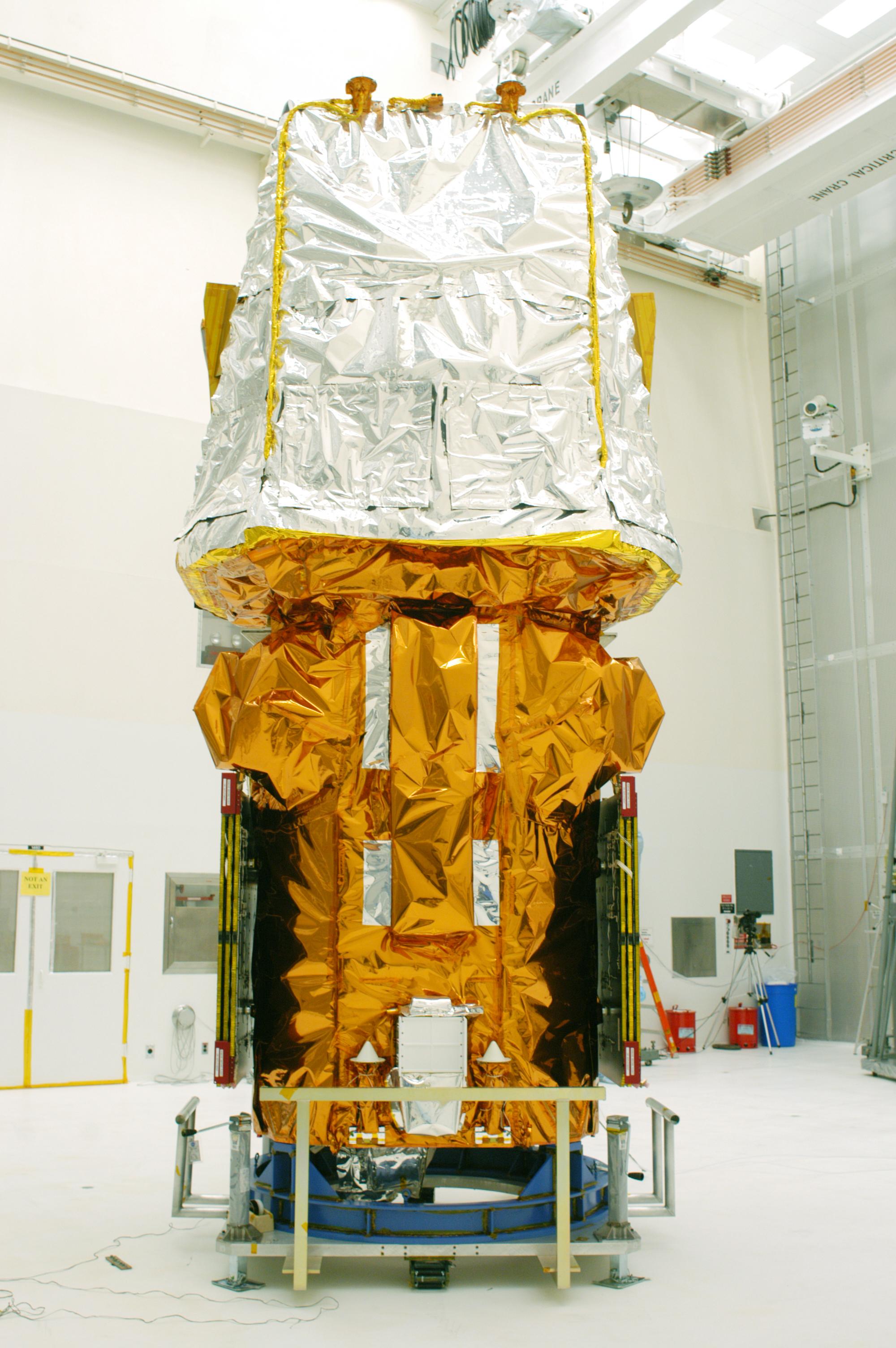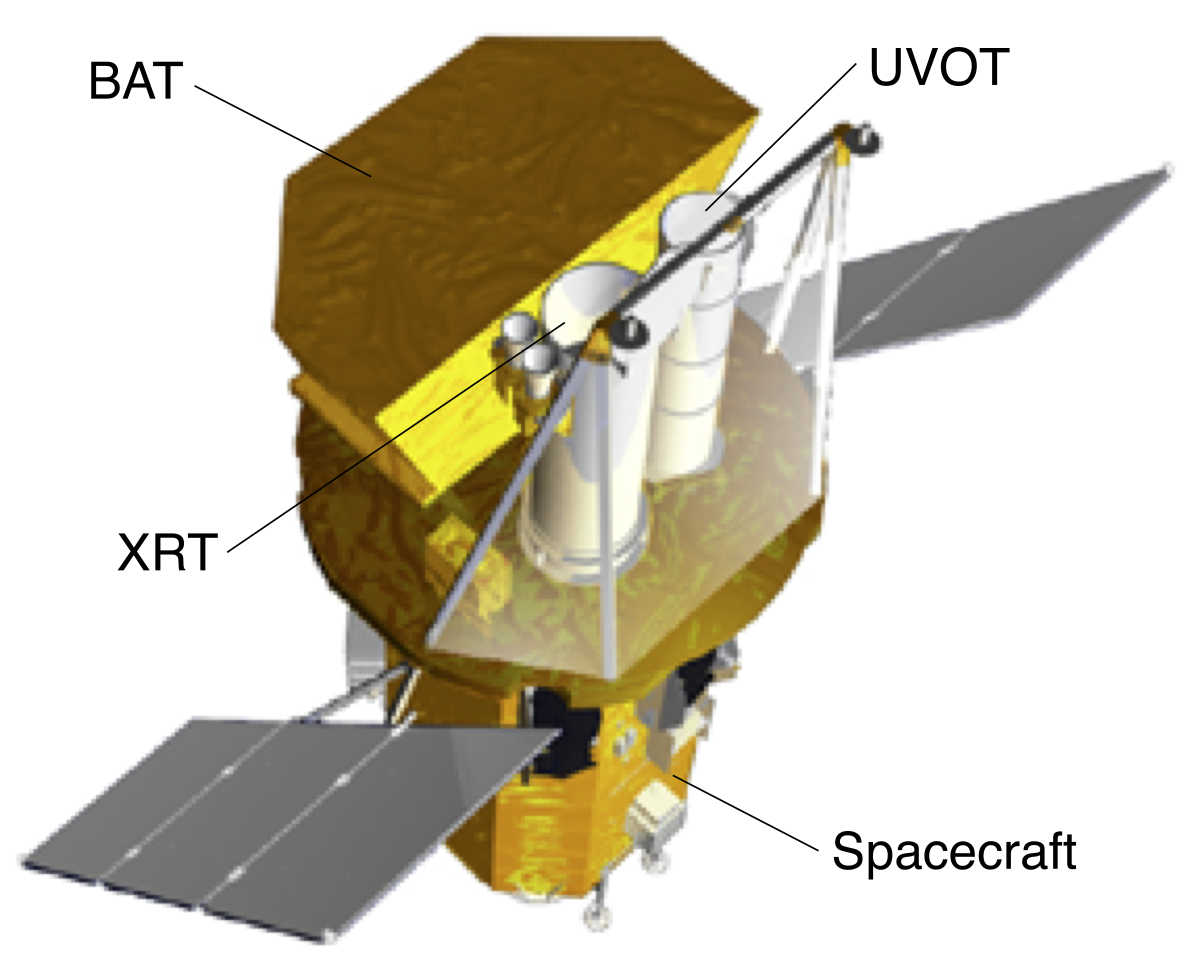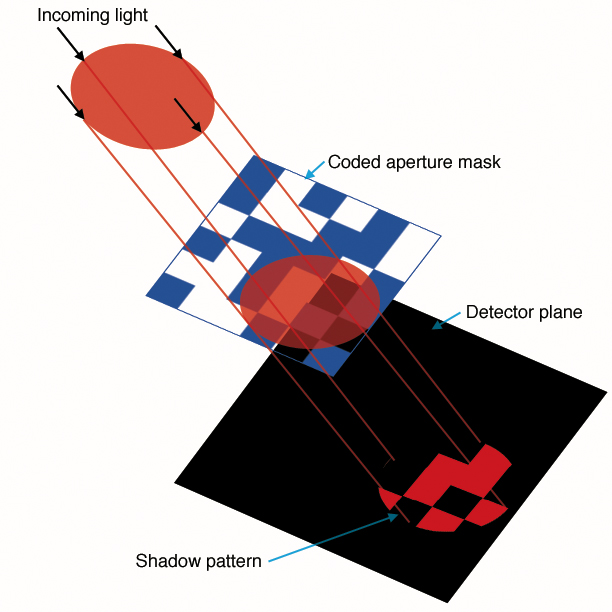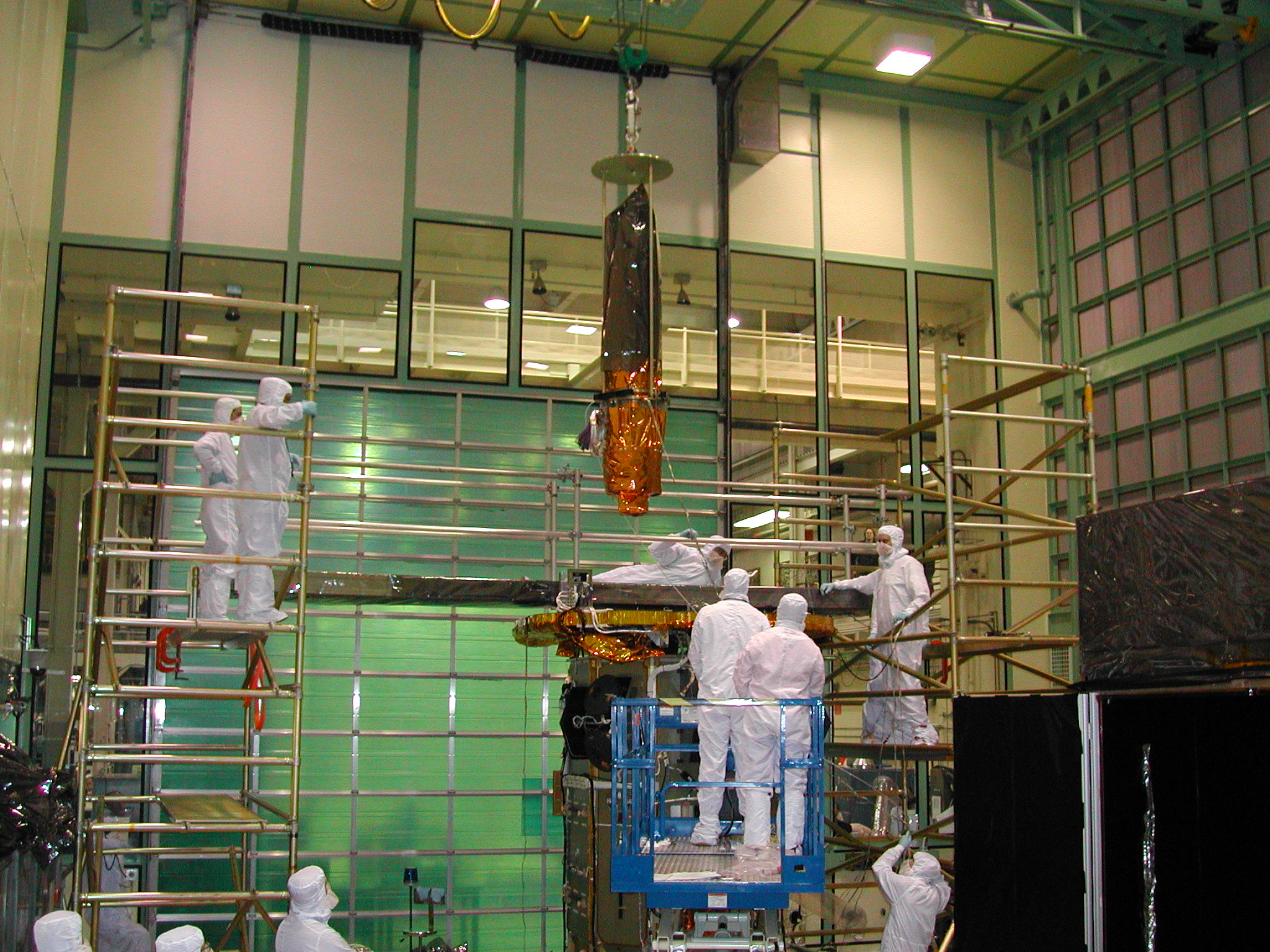Swift

At Cape Canaveral Air Force Station, the Swift spacecraft is revealed. (Credit: NASA)
The Swift Gamma-ray Burst Explorer is a NASA mission dedicated to investigating the mysterious phenomena of gamma-ray bursts (GRBs) - the most powerful events in the universe. Swift, launched on November 20, 2004, is a solar-powered satellite containing three different telescopes designed to view GRBs and their aftermaths in gamma-ray, X-ray, ultra-violet, and optical light. It gets its name from its ability to detect a GRB and then 'swiftly' turn to focus its telescopes on the afterglow. In fact, Swift moves quickly enough to allow scientists to view some GRB's in UV/optical light while they are occurring. Prior to Swift, optical light from a GRB in progress had only been observed once, in 1999 with a GRB called GRB 990123.
Swift is a part of the NASA medium explorer program designed with help from American universities and NASA's international partners.

Artist's concept of Swift as it observes a Gamma-ray burst. (Credit: Spectrum Astro)
Instrumentation
Swift has three main instruments: the Burst Alert Telescope (BAT), the X-ray telescope (XRT), and the UV/Optical telescope (UVOT). The main purposes of the instruments are to measure the location of the GRB and determine if there is also an "afterglow signal": a glowing ember of the burst in the longer wavelengths of X-rays, UV and optical. When an afterglow is present, the XRT and/or UVOT will be used to refine the position of the object so high precision ground based and space based observations may be performed.
The primary differences between the instruments are that they each look at a different part of the Electromagnetic Spectrum, providing us with three different eyeballs to view the universe.

An artists concept of Swift that shows the BAT, XRT, and UVOT. (Credit: Spectrum Astro)

A drawing of the BAT showing the aperture mask and detector plate.
The Burst Alert Telescope is one of the most important parts because it detects and locates the gamma-ray bursts. After detecting and locating a GRB, the BAT shares this information with Swift's onboard computer, which then autonomously moves to position the XRT and UVOT to view the afterglow of the burst. It also immediately sends the GRB data back to Earth where anyone can access it through the Gamma-ray Burst Coordinate Network.
The BAT is also important because when it's not viewing a GRB, it collects data to produce the most sensitive map of the sky at higher X-ray energies.
These amazing feats are accomplished with the BAT's coded aperture mask and its detector array. The aperture mask is a big metal sheet with random holes in it that casts a shadow on the detector plates. Since scientists know what the aperture mask looks like, they can use the shadow cast by a GRB on the detector to pinpoint the GRB's location. The BAT detector array is responsible for recording gamma-ray and X-ray data before it gets sent down to Earth. It is a thick semiconductor plate that measures the energy change caused by the gamma-rays that strike it.
The Ultra-Violet/Optical Telescope is a type of telescope called a Ritchey-Chrètien telescope. It has a long tube to collect light and several mirrors at the end to focus it into a detector. This detector takes images and spectra of the GRB afterglows. The images are used like maps of the stars to tell astronomers where the burst happened. In fact, they are able to obtain position localizations which can be use by ground based astronomers to view the location of the GRB themselves. The spectra help to determine redshifts of the GRBs, which are important because they give us information about how far away the burst is and when it happened.

The UVOT being installed on the spacecraft. (Credit: NASA)
The X-ray telescope uses special conically shaped mirrors left over from the JET-X program (Joint European X-ray Telescope). These mirrors help to focus the X-rays because X-rays pass through normal mirrors like those used in the UVOT. The cone shape of the mirrors funnels the X-rays to a detector by grazing them off of the mirrors at wide angles. After detecting the X-rays, the XRT confirms the location of the GRB and determines it's intensity. The XRT burst data is also used to provide spectra and light curves of the burst in the X-ray spectrum.
Data Analysis and Scientific Results
The Swift mission hopes to determine the origin of GRBs, investigate how the GRB blast wave interacts with the rest of the universe, and explore the origin of the universe. But before this exciting science is done, the data must be brought down from the satellite as telemetry and processed here on Earth. There are actually several places the data goes once it reaches Earth, but perhaps the most important is the Swift Data Center (SDC) at NASA's Goddard Space Flight Center.

A map of the path Swift's data takes before the public gets it here on Earth.
The SDC effectively acts just like an oil processing pipeline. First, data travels from the satellite to the center here on Earth. Then it gets stopped and refined at the data center which turns the information from the three telescopes into calibrated images, cleaned event lists, light curves, and spectra. The refined data then continues its journey on the pipeline where it is brought to scientists and the public through the SDC Quick Look Facility, which is a sort of gallery for the pictures, charts and data sheets that come out of the refinery. After one week, the pipeline data is finally moved for long term storage to data archives in the US (HEASARC), UK, and Italy.
The Gamma-ray burst Coordinate Network (GCN) is another path data can take from the satellite to Earth. Upon detecting a GRB, Swift immediately sends a position message to the GCN which places it on the internet. This allows scientists on Earth to turn their telescopes toward the GRB to observe it themselves. However, the GCN doesn't refine the data for the scientists like the SDC does. In this way, it is more like the severe weather warnings on TV than an oil pipeline. It tells you where and when the burst happens, but it doesn't provide lots of details.
Once all is said and done and the data is prepared, scientists will begin to work with it. Some of them are hired by NASA to work toward specific scientific goals (like classifying GRBs). Others are just freelance astronomers and academic researchers who retrieve the data from the archives to analyze it. This could be you! Once the data is processed at the SDC, all of it is made available to the public. There is no proprietary data that is made available only to scientists, a fact that makes Swift an even more unusual and special mission.
So, what do scientists hope to find out from the data? Click the links to find out what Swift may tell us about GRBs, the Early Universe, and the hard X-ray background. See what Swift could tell us about:
Swift Milestones
2004 → Swift detects a super burst from a magnetar (SGR1806-20)
2005 → Swift discovers the first afterglow of a short GRB (GRB 050509B)
2006 → Swift observes the first supernova shock break-out from a nearby GRB (GRB 060218)
2007 → Swift is awarded the Bruno Rossi Prize
2008 → Swift catches first supernova in the act of exploding (SN 2008D)
2009 → Swift detects farthest GRB, smashing cosmic distance records (GRB 090423)
2010 → Swift's BAT Survey finds 'Smoking Gun' of Black Hole Activation
2011 → Swift discovers the first relativistic tidal disruption event (Swift J1644 +57)
2012 → Swift discovers an anti-glitch in a magnetar (1E 2259+586)
2013 → Swift catches the first short GRB associated to a kilonova (GRB 130603B)
2014 → Swift's BAT Survey detects Titanium-44 emission from Tycho's SNR
Swift Guest Investigator Program
The Swift Guest Investigator (GI) Program solicits proposals for basic research relevant to the Swift mission. Proposals are due at the end of September each year and are evaluated in a peer-review process. Each year, more than 500 scientists all over the world apply to the Swift GI program. Up to 5 megaseconds (Ms), or almost 60 days, of Swift observing time is made available to study a wide variety of astrophysical sources: gamma-ray bursts, normal and active galaxies, novae, supernovae, comets, stars, and pulsars. The Swift GI Program also provides financial support for theoretical investigations of these sources, and for performing observations at other wavelengths, which will complement the Swift data. The Swift GI program encourages the development of new infrared facilities which will help us to identify the farthest GRBs, those happening in the very early Universe.
Published: September 2005
Text Reviewed: September 2018


